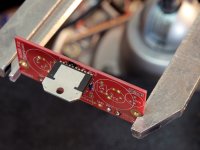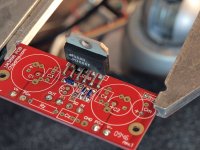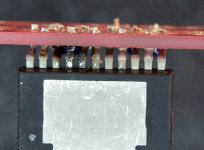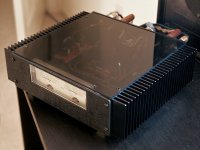Thank's, that idea comes from this forum actuallyAbsolutely Not. Good Compact Build.
^ Now,.. here come my lecturer,.without him, i won't be able to build any amp@guzz
nice one!! good job brother

Thank's,.. just like cars amplifierYeah Guzz, thats a pretty sweet little build. I like when the sinks can be used as the sides.
Uriah
my first chip-amp. some in-progress pics:
last photo was with the unit in operation. I think I installed the power led in backwards (or it was marked backwards!) but the unit really is on and running.
case is all DIY, using ABS plastic for the prototype and 2 car audio heatsinks from a concord brand amp, dating from the early 80s! removed all the amp guts and kept the valuable heatsinks, lol. the rest is just ABS plastic cut to size at TAP plastics. very cheap and if I got anything wrong, I can redo the panels for next to no cost. once I get a layout I like, then I can consider going metal.
the chips were 10+ year old samples I got from an AES show. they sat in a static box for all these years until I finally got around to building this from some new boards I got last week.
An externally hosted image should be here but it was not working when we last tested it.
An externally hosted image should be here but it was not working when we last tested it.
An externally hosted image should be here but it was not working when we last tested it.
An externally hosted image should be here but it was not working when we last tested it.
last photo was with the unit in operation. I think I installed the power led in backwards (or it was marked backwards!) but the unit really is on and running.
case is all DIY, using ABS plastic for the prototype and 2 car audio heatsinks from a concord brand amp, dating from the early 80s! removed all the amp guts and kept the valuable heatsinks, lol. the rest is just ABS plastic cut to size at TAP plastics. very cheap and if I got anything wrong, I can redo the panels for next to no cost. once I get a layout I like, then I can consider going metal.
the chips were 10+ year old samples I got from an AES show. they sat in a static box for all these years until I finally got around to building this from some new boards I got last week.
Don't Look Back
Those opamps would have looked perfect on one of those spaceship guitars on a 70's (Rock Group) Boston album!
Not an amp but a fun pic my buddy took of a couple LME49720HA opamps on a dirty MDF workbench at my shop.
Those opamps would have looked perfect on one of those spaceship guitars on a 70's (Rock Group) Boston album!
my first chip-amp....
An externally hosted image should be here but it was not working when we last tested it.
... they sat in a static box for all these years until I finally got around to building this from some new boards I got last week.
Quite Tidy! Excellent job with surplus / legacy parts ...

(I have begun using transparent plastic top & bottom for similar projects ... so as to see all the LEDs
Last edited:
My friend's work
Separate the design of the host and power.
LME49810 + 2SC5200/2SA1943 x3 Pairs
Separate the design of the host and power.
LME49810 + 2SC5200/2SA1943 x3 Pairs
An externally hosted image should be here but it was not working when we last tested it.
An externally hosted image should be here but it was not working when we last tested it.
An externally hosted image should be here but it was not working when we last tested it.
An externally hosted image should be here but it was not working when we last tested it.
An externally hosted image should be here but it was not working when we last tested it.
LM3886 in CD-Rom format )
This is an awesome idea!!!
ouch!! stop, stop, make the bad voltage go away!
this is what happens when you 'do things' with voltage applied that really didn't need to have voltage applied. that's all I'm gonna say, too (lol).
that same day I was able to drive over to a local parts supplier (jameco), get the 3886 chip and since I had spare red-boards, I was back in business later that day.
the smell of silicon (in the morning) has not gone away, though...
this is what happens when you 'do things' with voltage applied that really didn't need to have voltage applied. that's all I'm gonna say, too (lol).
that same day I was able to drive over to a local parts supplier (jameco), get the 3886 chip and since I had spare red-boards, I was back in business later that day.
the smell of silicon (in the morning) has not gone away, though...
Attachments
An externally hosted image should be here but it was not working when we last tested it.
An externally hosted image should be here but it was not working when we last tested it.
An externally hosted image should be here but it was not working when we last tested it.
An externally hosted image should be here but it was not working when we last tested it.
An externally hosted image should be here but it was not working when we last tested it.
Hello, This week i've been building that.
P88 Rod Elliot Preamplifier
2.1 Linkwitz-Riley 24db/oct crossover
TDA1557Q.
Regards.
the gainclone is mostly finished now.
the VU meters are a stoopid frill found them cheap on ebay and they seem to 'bounce around' which is all I needed for this silly thing. I'll figure out some circuit for it later on. maybe.
found them cheap on ebay and they seem to 'bounce around' which is all I needed for this silly thing. I'll figure out some circuit for it later on. maybe.
audio wise, its sounding very nice indeed. changed some default R settings (lowered gain quite a lot) and the noise level is now on par with the rest of my system. quite nice.
the VU meters are a stoopid frill
audio wise, its sounding very nice indeed. changed some default R settings (lowered gain quite a lot) and the noise level is now on par with the rest of my system. quite nice.
Attachments
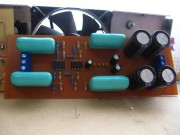
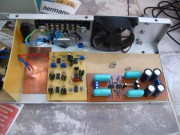 An externally hosted image should be here but it was not working when we last tested it.
An externally hosted image should be here but it was not working when we last tested it.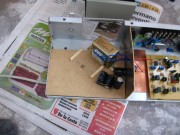
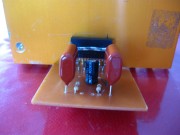
Hello, This week i've been building that.
P88 Rod Elliot Preamplifier
2.1 Linkwitz-Riley 24db/oct crossover
TDA1557Q.
Regards.
another try:
An externally hosted image should be here but it was not working when we last tested it.
An externally hosted image should be here but it was not working when we last tested it.
An externally hosted image should be here but it was not working when we last tested it.
An externally hosted image should be here but it was not working when we last tested it.
Meters
Analog meters can be tricky to deal with. They'll be really bouncy if the circuit does not provide meter damping. One can experiment with small electrolytics in the 1-47uf or so range to find a value that holds peaks for a second or two and install the correct value. Adding a cap will slow attack time if the driving circuit doesn't supply enough charge current for the cap.
the gainclone is mostly finished now.
the VU meters are a stoopid frillfound them cheap on ebay and they seem to 'bounce around' which is all I needed for this silly thing. I'll figure out some circuit for it later on. maybe.
audio wise, its sounding very nice indeed. changed some default R settings (lowered gain quite a lot) and the noise level is now on par with the rest of my system. quite nice.
Analog meters can be tricky to deal with. They'll be really bouncy if the circuit does not provide meter damping. One can experiment with small electrolytics in the 1-47uf or so range to find a value that holds peaks for a second or two and install the correct value. Adding a cap will slow attack time if the driving circuit doesn't supply enough charge current for the cap.
for the meter driver, I'm actually thinking (longer term) of a cpu-based solution. I do arduino programming and it might be possible to pull the spkr-out into the analog-in of the cpu, do the VU logic and log scaling there and then output a steady dc voltage for the benefit of the meter  that way you can control the attack and decay and even peak-hold all in software.
that way you can control the attack and decay and even peak-hold all in software.
Elegant!
With the pain in the a$$ that meter driver circuits can be, the digital approach is elegant.
for the meter driver, I'm actually thinking (longer term) of a cpu-based solution. I do arduino programming and it might be possible to pull the spkr-out into the analog-in of the cpu, do the VU logic and log scaling there and then output a steady dc voltage for the benefit of the meterthat way you can control the attack and decay and even peak-hold all in software.
With the pain in the a$$ that meter driver circuits can be, the digital approach is elegant.
- Home
- Amplifiers
- Chip Amps
- Chip Amp Photo Gallery
